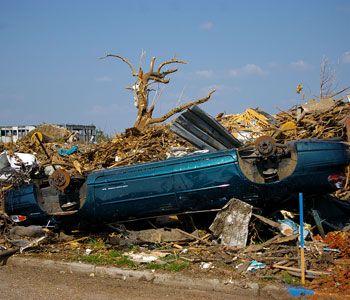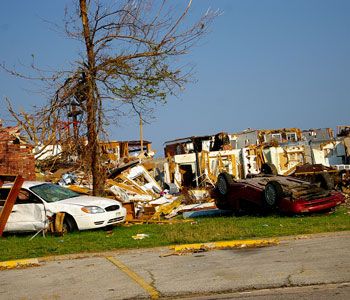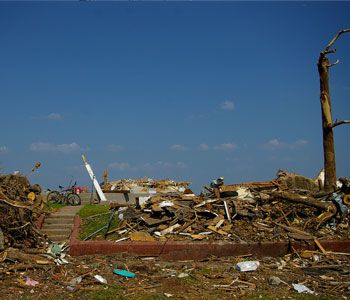4 ways technicians can help when disaster strikes
Hey technicians: Tired of feeling helpless when disaster strikes? There are many organizations seeking your expertise. You just have to find the one that's right for you.
Next >

Joplin, Mo. suffered severe damage from the May 22 EF-5 tornado. Click the next button to view more photos of the Joplin destruction. All photos by Troy Van Horn.
In light of recent disasters, like the wildfires and tornados, Firstline received requests for information on how technicians could help. We contacted contributor Tiah Schwartz, CVT, EMT, from Portland, Ore., to give us the scoop.
She says first you must determine which type of position you're looking for (volunteer, paid, full-time or part-time). Then search the Internet to see if your state has a response team. “For example, I'm on the Oregon Veterinary Emergency Response Team (OVERT),” says Schwartz. “It's a volunteer position. However, if your state participates in an Emergency Management Assistance Compact (EMAC) with other states, veterinary technicians may be paid for their time when deployed to a disaster.” EMAC, by definition, is a congressionally ratified organization that provides form and structure to interstate mutual aid.
Some organizations have optional deployment but for others deployment is mandatory. “When I'm deployed with the National Veterinary Response Team (NVRT), I'm covered under the Uniformed Services Employment and Reemployment Rights Act (USERRA) Act. I receive payment from U.S. Department of Health and Human Services so employers aren't required to pay me while I'm deployed,” Schwartz says. “However, employers must give leave with benefits. They can't make me use my vacation time either.”
Here are four options for veterinary technicians who want to serve on a disaster relief team or volunteer, according to Schwartz.
(Click here to continue to the next page.)

The Joplin tornado demolished thousands of buildings and cars, leaving about one-third of the town in ruins. Wind speeds were estimated at 198 mph.
1. National Veterinary Response Team (NVRT)
Mission: The NVRT identifies the need for veterinary services following major disasters, emergencies, and other events requiring federal support. Members assess the disruption to animal and public health infrastructures. The NVRT is a fully supported federal program and was formerly under the Department of Homeland Security and the Federal Emergency Management Agency. NVRT members' responsibilities include:
- Assessing the community's veterinary needs
- Medical treatment and stabilization of animals
- Animal disease surveillance
- Zoonotic disease surveillance and public health assessments
- Technical assistance to assure food safety and water quality
- Hazard mitigation
- Care and support of animals certified as official responders to a disaster or emergency.
Time commitment: Mandatory deployment in the National Disaster Medical Systems under the Department of Health and Human Services. "You're usually deployed for two weeks," Schwartz says. "But deployment could be longer depending on the disaster and your availability."
Type of position:“You're paid when deployed and paid when completing training exercises. I am a member of NVRT-4, which covers the West Coast region,” Schwartz says. “There are five different regions. You're placed with the team in the region where you are currently residing.”
Learn more:Click here to find out how to get involved with the NVRT.
(Click here to continue to the next page.)

The Joplin tornado killed 153 people and displaced hundreds of animals. The multi-vortex tornado also caused millions in damages.
2. National Animal Health Emergency Response Corps (NAHERC)
Mission: When an animal health emergency occurs, an immediate response is necessary to protect both animals and people. The United States Department of Agriculture's (USDA) Animal and Plant Health Inspection Service (APHIS) look to many sources to obtain the veterinary personnel needed to help meet the critical staffing needs of such an emergency.
In 2001, APHIS established the NAHERC to respond to exotic disease outbreaks and other disasters which affect livestock, poultry, companion animals, and wildlife. According to their website, more volunteers are urgently needed to assure a decisive response to any potential animal health crises. NAHERC members' responsibilities include:
- Defend U.S. agriculture
- Help animals in need
- Expand career options
- Network within the veterinary community
- Learn emergency response procedures
- Travel and explore.
Time commitment: Similar to the NVRT program, however, you choose whether you want to be deployed. Assignments usually last between 21 and 30 days. You also have the right to refuse assignments.
Type of position: Paid under the U.S. Department of Agriculture (USDA). Travel, lodging, overtime, and workman's compensation also provided.
Learn more:Click here to find out how to get involved with the NAHERC.
(Click here to continue to the next page.)

"It was violent," says Joplin veterinarian Dr. Jim Christman. "You could just hear things breaking. You could hear debris hitting everything: cars, houses, trees."
3. Veterinary Medical Assistance Team (VMAT)
Mission: Members serve as first responders to ensure high-quality care of animals during disasters and emergencies. When requested by a state, VMATs provide operational assistance in emergency response programs to state animal health authorities and organize and provide training preparedness programs to animal health authorities and veterinary medical associations. This team is sponsored by the AVMA and supported by American Veterinary Medical Foundation. “Many members of VMAT are also NVRT or NAHERC members,” Schwartz says. VMATs' responsibilities include:
- Assess veterinary conditions and need as soon as possible
- Primary field care to augment overwhelmed local capabilities
- Emergency-related lectures and training for state veterinary associations, professionals and colleges, regarding emergency animal medical assistance
Time commitment: You'll be deployed for 72 hours at a time.
Type of position: Volunteer
Learn more:Click here to find out how to get involved with the VMAT.
(Click here to continue to the next page.)
Back >

After Dr. Jim Christman, owner of Parkview Animal Hospital in Joplin, Mo., confirmed the safety of his patients, he sprayed paint, "pets ok" on the outside of the building.
4. General knowledge through online training
Prior to deployment with NVRT or NAHERC you must complete the following Incident Command System (ICS) courses:
ICS 700 (National Incident Management Training)
ICS 800 (National Response Plan)
The NAVERC also encourages you to take the following courses:
IS-10: Animals in Disasters "Awareness & Preparedness"
IS-11: Animals in Disasters "Community Planning"
Learn more:Click here to access the NAHERC Training website and click here to access the Emergency Management Institute (EMI) independent study website.
Educational tools: The USDA NAHERC offers two online courses available for team members who want to learn more about animal diseases and how to handle them when they spread throughout the country.
Vesicular Diseases:
The first part of this module addresses the importance of foot-and-mouth disease, vesicular stomatitis, swine vesicular disease, and vesicular exanthema of swine in the United States. Clinical signs associated with the four vesicular diseases and specific biosecurity measures are included. The second part of this module takes you through an interactive scenario investigating a possible vesicular disease outbreak on a swine farm. You'll learn the process of reporting a possible vesicular disease case and the chain of events that occur in a foreign animal disease investigation.
Exotic Avian Diseases:
The first part of this module addresses two very important diseases of birds-avian influenza and exotic Newcastle disease-and their potential economic impact on the U.S. economy. Clinical signs associated with these diseases and specific biosecurity measures to implement are included. In the second part of this module, you'll progress through an interactive scenario where one of these diseases is potentially introduced into the U.S. through the pet bird industry. You'll learn the process of reporting a possible exotic avian disease and the chain of events that occur in a foreign animal disease investigation.
Learn more:Click here to access the online courses.